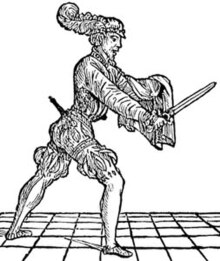Cloak and dagger

"Cloak and dagger" was a fighting style common in the Renaissance involving a knife hidden beneath a cloak. The term later came into use as a metaphor, referring to situations involving intrigue, secrecy, espionage, or mystery.
Overview
In "The Knight's Tale", published around 1400, English poet Geoffrey Chaucer referred to "The smiler with the knife under the cloak".[1]
Taken literally, the phrase could refer to using the cloak and dagger in
The metaphorical meaning of the phrase dates from the early 19th century. It is a translation from the French de cape et d'épée and Spanish de capa y espada ("of cloak and sword"). These phrases referred to a genre of swashbuckler drama in which the main characters wore these items. In 1840, Henry Wadsworth Longfellow wrote, "In the afternoon read La Dama Duende of Calderón – a very good comedy of 'cloak and sword'." Charles Dickens subsequently used the phrase "cloak and dagger" in his work Barnaby Rudge a year later as a sarcastic reference to this style of drama.[4] The imagery of these two items became associated with the archetypal spy or assassin: the cloak, worn to hide one's identity or remain hidden from view, and the dagger, a concealable and silent weapon.[citation needed]
In contemporary culture
The sword fight in Peter Martins' ballet of Romeo + Juliet culminates in Romeo stabbing Tybalt repeatedly in the back with a dagger, having flung his cloak over the latter's head.
The Spy in Team Fortress 2 owns a wristwatch called "The Cloak and Dagger", alluding to his affinity towards knives and backstabbing.
SEAL Team ONE's unit logo features a seal wrapped in a cloak, holding a dagger, referencing the nature of their clandestine missions.
References
- ^ Geoffrey Chaucer,"The Knight's Tale" in Canterbury Tales c 1400.
- ^ DiGrassi, His True Arte of Defence The entire Di Grassi manual translated into English.
- ^ UNC.edu A version of "The Rapier and Cloake" that is easier to read and includes an illustration.
- ISBN 0-14-043728-2.
...his servant brought in a very small scrap of dirty paper, tightly sealed in two places, on the inside whereof was inscribed in pretty large text these words: A friend. Desiring of a conference. Immediate. Private. Burn it when you've read it. "Where in the name of the Gunpowder Plot did you pick up this?" said his master. "It was given him by a person then waiting at the door", the man replied. "With a cloak and dagger?" said Mr Chester.
